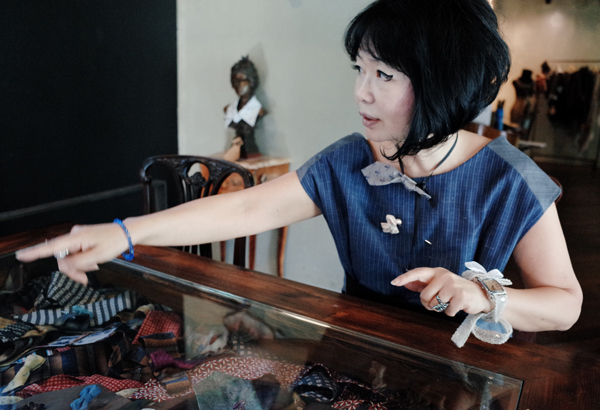Tie Museum a tribute to sartorial excellence

Lee Kyung-soon, CEO of fashion brand Nouveautes, explains the exhibits at the Tie Museum. By Han Young-ik
Located in Seongbuk-dong, in northern Seoul, Tie Museum is full of antique furniture, some items as much as 200 years old, and neckties, as old as 100 years. There is also a restaurant.
More than 25,000 neckties are exhibited in the 839-square-meters (9,000-square-feet) museum.
Lee has gained recognition for her necktie designs, which have included the Korean flag (the blue-and-red yin-and-yang symbol) and the eight Taoist trigrams (like the black bars on the Korean flag).
Football coach Guus Hiddink even wore one of her ties when he was the coach of the Korean national team during a World Cup game in 2002 in Korea. She also designed a Dokdo necktie for UN Secretary General Ban Ki-moon, back when he was the Minister of Foreign Affairs and Trade.
Utilizing the embassy residences in the neighborhood, Lee and the district superintendent Kim Young-bae are preparing an event for Embassy Day on Oct. 18. Lee plans to sell artworks that have been donated to the museum by embassies around the world to raise money for senior citizens who live alone.
Q. How did you collect 25,000 neckties by yourself?
A. I collected them little by little over decades, whenever I went overseas. The same goes for the furniture. I purchased them, wrapped them and transported them in a container by myself.
Why did you start a museum?
One day, I just thought you never know when and how you might die. Car accidents can happen. As I thought that, I decided I should do something so others could appreciate them, instead of just leaving them at home. Then everything went quickly. It only took five minutes to decide the location for the museum. From purchasing the museum site to the museum opening, it took six weeks. I decorated the interior myself.
The land must have cost a lot.
Located among the high-price homes of Seongbuk-dong, customers and acquaintances occasionally speak of land costs. The truth is, I get upset when I hear those stories. The items on display are just as expensive as the land. For the oldest neckties of 100 years old, there are some that cost more than 5 or 6 million won ($4,600-5,600). Altogether, the neckties here must amount to 7 billion won, and the furniture 1.2 billion won. Yet I’m not talking about money. I have collected these items one by one since I was 20 years old. They are worth more than money to me.
How are you going to manage the museum?
I will run it with the help of volunteers from the neighborhood. A museum can be loved when the nearby residents are happy. I made a brunch menu after I met two elderly ladies who live alone who said there wasn’t any place to eat. I do not think of it as loss because I never thought of making a profit here anyway. Some people have dropped by to donate neckties, even though the museum has only been open a couple of weeks. CEOs from major companies visit but also senior citizens from nearby come. I always serve them coffee to thank them.
BY HAN YOUNG-IK [estyle@joongang.co.kr]










with the Korea JoongAng Daily
To write comments, please log in to one of the accounts.
Standards Board Policy (0/250자)